
Browse an alphabetical list of photographs. These historical images portray people, places, and events before, during, and after World War II and the Holocaust.
<< Previous | Displaying results 126-143 of 143 for "Photo" | Next >>
Two young cousins shortly before they were smuggled out of the Kovno ghetto. A Lithuanian family hid the children and both girls survived the war. Kovno, Lithuania, August 1943.

Two French partisans, Missak Manouchian (left) and Wolf Wajsbrot (right), who belonged to the French armed resistance group Francs-Tireurs et Partisans. They were executed by firing squad on February 21, 1944. Paris, France, February, 1944.

Two German Jewish families at a gathering before the Nazi rise to power. Only two people in this group survived the Holocaust. Germany, 1928.
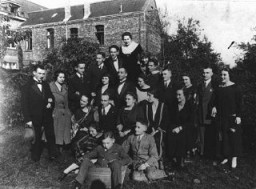
Portrait of two Jewish girls dressed in traditional Macedonian costume in a private home in Bitola. Pictured are Matilda Kamchi (or Camhi, left) and a friend. Both perished in Treblinka. Bitola, 1937.
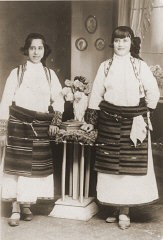
Two Jewish men, wearing badges identifying them as Jews, stand before SS men in the Ponary forest outside Vilna. Ponary served as the main Nazi killing site for Vilna's Jewish inhabitants. ca. July 1941.
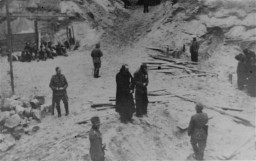
Bedukian Sarkis, a French partisan of Armenian extraction, patrols a street along with another partisan during the August 1944 insurrection in the south of France. Marseille, France, August 1944.
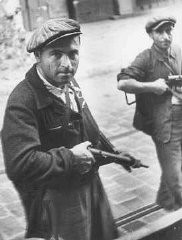
Two malnourished Soviet prisoners of war, survivors of the Hemer prisoner of war camp in western Germany. More than three million Soviet prisoners of war died in German custody, mostly from malnutrition and exposure. Hemer, Germany, April 29, 1945.
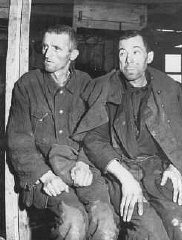
Portrait of two men standing in a doorway in the former Budapest ghetto, one of whom is wearing a painted yellow star on his jacket. Photograph taken by Yevgeny Khaldei. Budapest, Hungary, 1945.
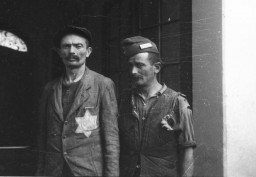
Photograph of two of the Tehran Children, who reached Palestine in 1943 via Iran.

Two ovens inside the crematorium at the Dachau concentration camp. Dachau, Germany, July 1, 1945. This image is among the commonly reproduced and distributed images of liberation. These photographs provided powerful documentation of the crimes of the Nazi era.
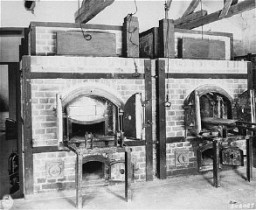
Two political prisoners, after US soldiers liberated the Gusen concentration camp. Austria, May 12, 1945.
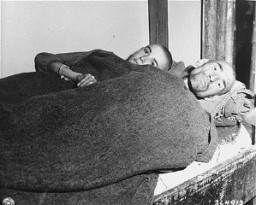
Close-up portrait of two prisoners in the Im Fout labor camp in Morocco. The camp was approximately 59 miles southwest of Casablanca, and housed a group of foreign workers. Many of the prisoners fell ill because of poor living conditions in the camp. Im Fout, Morocco, 1941-42.
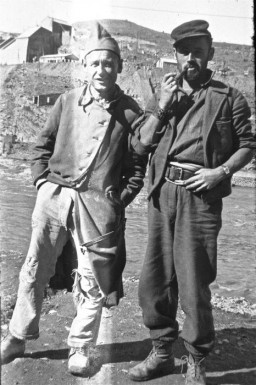
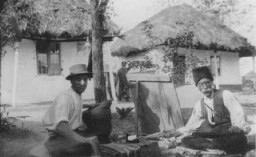
Two survivors in front of the women's barracks in the Bergen-Belsen concentration camp. Bergen-Belsen, Germany, April 1945. © IWM (BU 3740)
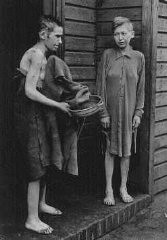
Two survivors prepare food outside the barracks in Dachau, Germany, May 1945. This image is among the commonly reproduced and distributed images of liberation. These photographs provided powerful documentation of the crimes of the Nazi era.
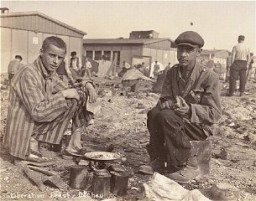
Two American soldiers cross the Rhine River into Germany on March 29, 1945. In the foreground is Jack Caminer, who emigrated from Germany to the United States in 1938. After he was drafted into the US Army, Caminer was sent to Camp Ritchie to prepare for intelligence work. Caminer participated in the liberation of Ohrdruf.
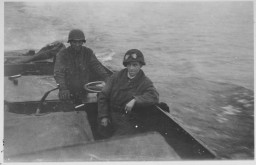
A young boy holding his younger brother in the Kovno ghetto. Older children frequently cared for younger siblings in the ghetto. Photographed by George Kadish. Kovno, Lithuania, 1941.
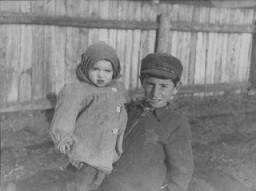
Two young brothers, seated for a family photograph in the Kovno ghetto. One month later, they were deported to the Majdanek camp. Kovno, Lithuania, February 1944. Pictured are Avram (5 years) and Emanuel Rosenthal (2 years). Emanuel was born in the Kovno ghetto. The children, who were deported in the March 1944 "Children's Action," did not survive. Their uncle, Shraga Wainer, who had asked George Kadish to take this photograph, received a copy of it from the photographer after the war in the Landsberg…
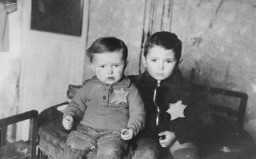
We would like to thank Crown Family Philanthropies, Abe and Ida Cooper Foundation, the Claims Conference, EVZ, and BMF for supporting the ongoing work to create content and resources for the Holocaust Encyclopedia. View the list of donor acknowledgement.